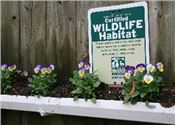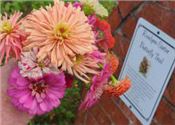Gladden A Late-Summer Garden With Gladiolas
DAVID TRINKLEIN
COLUMBIA, MISSOURI
Few flowers bring more late-summer gladness than gladiolas, says University of Missouri Extension horticulturist David Trinklein.
Their colorful flowers are known botanically as spikes. Individual flowers on the spike are called florets. “Glads are somewhat unique in that the florets on the spikes all point in the same direction,” Trinklein says.
In Missouri, glads grow as annuals, but some species grow as perennials in warmer climates, he says.
Glads vary in height, flower form and size. Popular types include grandiflora hybrids with large individual florets and tall spikes; dwarf grandiflora hybrids, which are about half the size of grandiflora hybrids; and gladiolus nana hybrids, which are smaller yet than the dwarf hybrids.
Corm selection
The food-storage structures of glads are swollen underground stems called corms. Each year a new corm forms on top of the old one, which shrivels and dies.
Healthy corms are essential to produce vigorous plants with flowers of maximum size. A healthy corm should be firm, smooth, undamaged and without discoloration.
The size of the plant and flowering spike produced is directly related to the size of the planted corm. Corms are graded into sizes such as Jumbo (2 inches or more in diameter), Number One (1½ to 2 inches in diameter) and Number Two (1¼ to 1½ inches in diameter).
Site selection
Glads grow well in sunny exposures. They do well in many soil types but prefer loam or sandy loam with a pH of 6.0-6.5. Soils that produce good potatoes, corn or other garden vegetables will produce good glads.
Planting
Glads may be planted a month before the average last frost date and at two-week intervals thereafter for a succession of blooms. The last planting should be no later than early July so that the corms have time to develop and mature before frost.
Plant large corms 4-6 inches deep, medium-sized corms 3-4 inches deep and small corms 2-3 inches deep. Cover only 2 inches in the beginning and pull soil to the plants with each cultivation.
Staking
Staking is often necessary to ensure tall, straight flower spikes, especially on the taller types. You can use 1-by-1-inch stakes made from any suitable lumber. Tie the spikes to the stakes with soft twine or cloth strips at about 10-inch intervals.
Fertilizer side-dressing
A side-dressing of fertilizer after the plants are well established will increase vigor. Apply a 5-10-5 fertilizer to each row. This can be applied in a band on one side of the row, keeping 4 to 6 inches away from the stems.
Cutting flowers
Glads look best in the garden when mature flowers are harvested.
Spikes should be cut in their prime for maximum life indoors. Cut the spike when the first floret is showing color. To cut the spike, insert a sharp knife above the second to fourth leaf and make a slanting cut up the stem. Immediately immerse the cut spike in water.
Digging and storing corms
“At our latitude, corms are not winter-hardy and must be dug if they are to be used the following year,” Trinklein says. Be ready to dig four to six weeks after blooms are finished or when the tops die off.
After digging, wash soil off the corm and roots. Cut the tops to within a half inch of the corm. Corms can be left outdoors in the sun for a day or two if temperatures are mild and then spread out in a light, airy place to cure. They should be stored during the winter at a temperature of 35-45 F in a well-ventilated area.
Learn more about this summer delight in David Trinklein’s article “Glads: As American as Apple Pie” at ipm.missouri.edu/MEG/2022/5/ glads-DT. Portions of this article were adapted from an article by the National Garden Bureau. ∆
DAVID TRINKLEIN: University of Missouri
Gladiola cultivar "Tantastic."
Photo by Uleli, CC BY 3.0
(https://creativecommons.org/licenses/by/3.0), via Wikimedia Commons.
Garden Badges Boast Of Gardening, Conservation
DR. GARY BACHMAN
MISSISSIPPI STATE, MISSISSIPPI
Several years ago, many businesses and organizations began offering digital badges to replace the traditional certificates that signify the successful completion of some specialized, non-accredited course or workshop. These badges are icons or symbols that offer instant recognition of the expertise of the individual.
If you’re a fan of social media like I am, then you certainly know about group badge icons. These designations easily identify roles and interests of group members, such as admin/moderator, new member, conversation starter or expert.
But you may not know that there are badges your garden and landscape can earn and that you can share so your friends and neighbors will know about your expertise.
These are more like certificates, but like the digital badge, they offer instant recognition to neighbors and others passing by your garden and landscape.
The first garden badge my garden earned was Certified Wildlife Habitat from the National Wildlife Federation.
My garden and landscape provide sources of food, water and cover, as well as areas to raise babies. I also engage in sustainable gardening practices. Providing these resources for local wildlife is important, as natural habitats are being lost to rapid urban development. A big, 150-plus home development is currently under construction just down the street from my home garden.
For more information on becoming a Certified Wildlife Habitat, visit https://www.nwf.org/Garden-for-Wildlife/Certify
. My garden’s second badge involved becoming a member of the Rosalynn Carter Butterfly Trail.
The idea for this trail was inspired by former First Lady Rosalynn Carter to help increase the habitat of the Monarch butterfly. This trail program started in Plains, Georgia, and has registered gardens all over the United States. I was privileged to have been an invited speaker at the 2022 Rosalynn Carter Butterfly Symposium held just a few weeks ago.
For more information on the Rosalynn Carter Butterfly Trail, visit https://rosalynncarterbutterflytrail.org/join-the-rosalynn-carter-butterfly-trail
. I’ve recently become a member of Monarch Watch, and I’m waiting for my newest garden badge, the Monarch Waystation plaque.
My garden and landscape were certified as a Monarch Waystation for providing the resources necessary for the Monarch butterflies to produce successive generations and thus sustain their incredible migration across North America. This involves planting forage for the caterpillars and nectar plants to feed the butterflies. I’ve started seeds to grow seven Mississippi native milkweeds, and of course I have lots of nectar-rich flowers.
For more information on becoming a Monarch Waystation, visit https://www.monarchwatch.org/waystations . Meeting the requirements to earn these badges is not difficult. You simply confirm that you are or will practice good gardening or conservation practices. Generally, these certifications charge a nominal fee for the badge that you can proudly display. ∆
DR. GARY R. BACHMAN: Extension/Research Professor, MSU Extension

